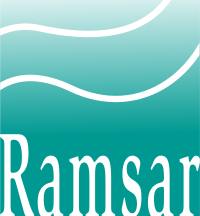Ramsar Convention
The Ramsar Convention (The Convention on Wetlands of International Importance, especially as Waterfowl Habitat) is an international treaty to protect wetlands.[1] It is meant to stop the loss of wetland areas now and in the future. It recognizes that wetlands are an important ecosystem. It also recognizes that wetlands have economic, cultural, scientific, and recreational value. It is named after the town of Ramsar in Iran.

Convention
changeThe convention was developed and agreed to by 18 nations at a meeting in Ramsar on February 2, 1971. It came into force on December 21, 1975.
The Ramsar List of Wetlands of International Importance now includes 2,429 sites, which are called Ramsar Sites, covering around 254,611,076 hectares.[1] This has increased from 1,021 sites in 2000. The nation with the most sites is the United Kingdom at 168. The nation with the greatest area of listed wetlands is Canada, with over 130,000 km², including the Queen Maud Gulf Migratory Bird Sanctuary at 62,800 km².[2]
There are now 159 nations that have agreed to the convention. The nations meet every three years as the Conference of the Contracting Parties (COP). The first meeting was held in Cagliari, Italy, in 1980. Changes to the original convention have been agreed to in Paris (1982) and Regina (1987).[3]
There is a standing committee, a scientific review panel, and a secretariat. The headquarters is in Gland, Switzerland, shared with the IUCN.
List of contracting parties
changeAlbania, Algeria, Argentina, Armenia, Australia, Austria, Azerbaijan, The Bahamas, Bahrain, Bangladesh, Belarus, Belgium, Belize, Benin, Bermuda, Bolivia, Bosnia and Herzegovina, Botswana, Brazil, Bulgaria, Burkina Faso, Burundi, Cambodia, Canada, Chad, Chile, China, Colombia, Comoros, Republic of the Congo, Costa Rica, Côte d'Ivoire, Croatia, Cuba, Cyprus, Czech Republic, Democratic Republic of the Congo, Denmark, Djibouti, Dominican Republic, Ecuador, Egypt, El Salvador, Equatorial Guinea, Estonia, Finland, France, Gabon, The Gambia, Georgia, Germany, Ghana, Greece, Guatemala, Guinea, Guinea-Bissau, Honduras, Hungary, Hong Kong, Iceland, India, Indonesia, Iran, Ireland, Israel, Italy, Jamaica, Japan, Jordan, Kenya, Kyrgyzstan, Latvia, Lebanon, Liberia, Libya, Liechtenstein, Lithuania, Luxembourg, Madagascar, Malawi, Malaysia, Mali, Malta, Mauritania, Mauritius, Mexico, Moldova, Monaco, Mongolia, Morocco, Namibia, Nepal, Netherlands, New Zealand, Nicaragua, Niger, Nigeria, Norway, Pakistan, Palau, Panama, Papua New Guinea, Paraguay, Peru, Philippines, Poland, Portugal, North Macedonia, Romania, Russia, Saint Lucia, Senegal, Serbia, Sierra Leone, Slovakia, Slovenia, South Africa, South Korea, Spain, Sri Lanka, Suriname, Sweden, Switzerland, Syria, Tajikistan, Tanzania, Thailand, Togo, Trinidad and Tobago, Tunisia, Turkey, Turkmenistan, Uganda, Ukraine, United Kingdom, United States, Uruguay, Uzbekistan, Venezuela, Vietnam, Zambia, former USSR.
New contracting parties: Antigua and Barbuda (02.10.05), Cape Verde (18.11.05), Central African Republic (05.04.06), Iraq (17.02.08), Kazakhstan (15.01.07), Lesotho (01.11.04), Marshall Islands (13.11.04), Montenegro (succ. 03.06.06), Mozambique (03.12.04), Myanmar (17.03.05), Rwanda (01.04.06), Samoa (06.02.05), Seychelles (22.03.05), Sudan (07.05.05), Turkmenistan (03.07.09), United Arab Emirates (29.12.07), Yemen (08.02.08).
References
change- ↑ 1.0 1.1 Ramsar official website, retrieved 2021-08-19
- ↑ Ramsar Contracting Parties, retrieved 2009-11-07
- ↑ Ramsar: A brief history, retrieved 2009-11-07
Other websites
change- The Ramsar Convention on Wetlands
- Ramsar Sites Information Service Archived 2013-09-01 at the Wayback Machine, web service by a non-profit organisation Wetlands International, providing access to Ramsar database
- United States National Ramsar Committee Archived 2010-10-15 at the Wayback Machine
- Peace Palace Library, bibliography on Water resources and International law.
- Ramsar Standing Committee Addresses Climate Change and Biofuels[permanent dead link]
- Threats to Ramsar Wetlands in Coastal New South Wales, Australia Archived 2011-10-04 at the Wayback Machine